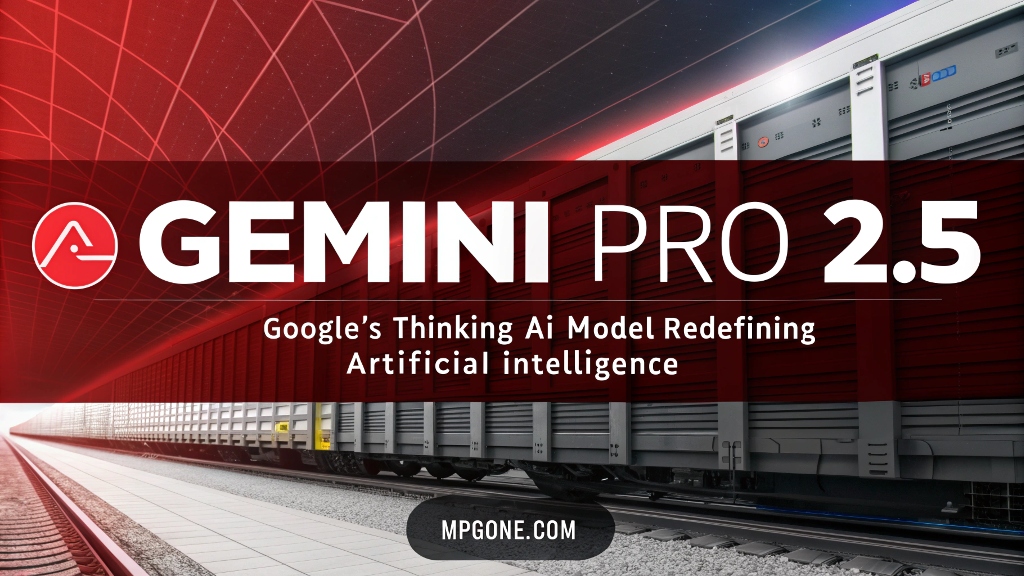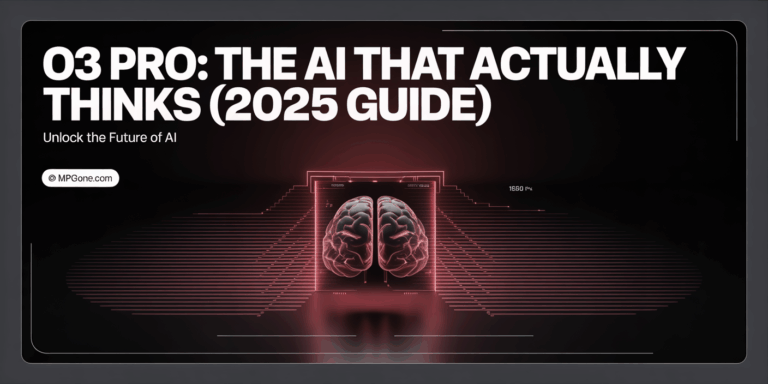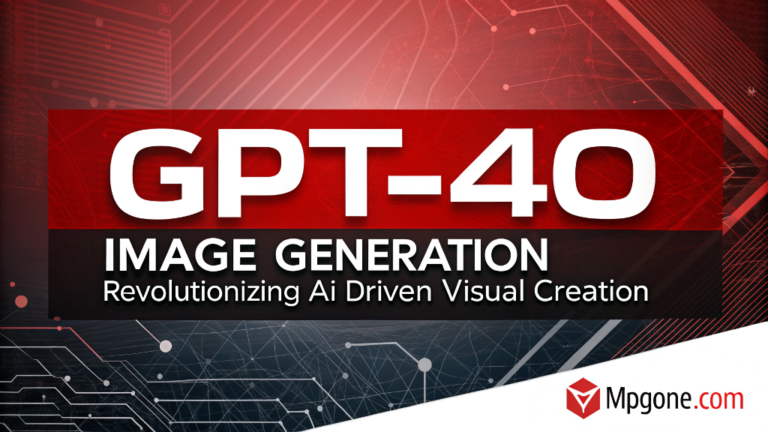Gemini Pro 2.5: Google’s Thinking AI Model Redefining Artificial Intelligence
Gemini Pro 2.5 is Google’s most advanced AI model yet and the first that can “think” before It answers a question. This breakthrough technology processes information differently from the normal computer chip manner, instead working through problems step by step before it understands and can respond. With its one million-token context window, multimodal capabilities, and ability to code as well?its design team really went far ahead in structural automation of human-computer interaction devices. Gemini Pro 2.5 is a great leap for artificial intelligence development.
Part of a family of “thinking models” launched by Google, Gemini Pro 2.5 stands out for its outstanding reasoning capabilities. This makes it particularly valuable for businesses and developers who need an AI system that can understand subtle instructions and complex problems. One model can process the totality of an organization’s code, whether it is in English or any other language.
What sets Gemini Pro 2.5 apart is that its implications for real-world AI applications. From being able to write better software code to analyses of long documents, the model consistently outperforms all previous AI systems on industry benchmarks. For organizations looking at implementing cutting-edge AI solutions, Gemini Pro 2.5 offers unprecedented capabilities that are set to change how people perform complex information processing tasks.
Evolution of Gemini Models
Google’s Gemini has grown rapidly since its first release. As someone who has watched AI develop for the last few years, I’m amazed at how quickly these models have improved. Let’s explore how Gemini has evolved from its beginnings to the powerful Gemini Pro 2.5 we see today.
From Gemini 1.0 to 2.5: A Timeline of Innovation
The Gemini journey shows how fast AI can change in just a short time. Here’s how it happened:
December 2023: Gemini 1.0 Launch Google released Gemini 1.0 as their answer to OpenAI’s GPT models. It came in three sizes:
- Gemini Ultra: The most powerful version
- Gemini Pro: The balanced option
- Gemini Nano: Designed for mobile devices
This first version showed promise but had limitations in handling complex reasoning tasks and working with long texts.
February 2024: Gemini 1.5 Release Just two months later, Google launched Gemini 1.5, which brought a huge improvement:
- The ability to work with up to 1 million tokens of context
- Better multimodal capabilities (handling text, images, audio, and video)
- Improved reasoning across different types of content
This update was a game-changer for tasks requiring analysis of long documents or multiple files at once.
December 2024: Gemini 2.0 Introduction The 2.0 release marked a significant leap forward with:
- Flash Thinking technology for faster reasoning
- Enhanced ability to understand and generate code
- Better performance on complex math and science problems
- More natural conversations with fewer hallucinations
March 2025: Gemini Pro 2.5 Experimental Launch The latest version brings refinements that make it even more powerful:
- Further improved context handling
- More precise reasoning capabilities
- Enhanced multimodal understanding
- Better performance on specialized tasks like medical diagnosis and legal analysis
Here’s a comparison table showing key improvements across versions:
| Feature | Gemini 1.0 | Gemini 1.5 | Gemini 2.0 | Gemini Pro 2.5 |
|---|---|---|---|---|
| Context Window | 32K tokens | 1M tokens | 1M tokens | 1M+ tokens |
| Reasoning | Basic | Improved | Flash Thinking | Advanced Thinking |
| Multimodal | Limited | Enhanced | Strong | Sophisticated |
| Specialized Tasks | Poor | Fair | Good | Excellent |
| Hallucinations | Common | Reduced | Minimal | Very Rare |
The Thinking Model Breakthrough
What makes Gemini Pro 2.5 special isn’t just its bigger context window or faster processing. The real breakthrough is in how it “thinks.”
Evolution of Reasoning Capabilities
Early AI models like Gemini 1.0 struggled with complex reasoning. They would often:
- Jump to conclusions too quickly
- Miss important logical steps
- Fail to connect related pieces of information
Google’s researchers tackled this problem through several approaches:
- Reinforcement Learning from Human Feedback (RLHF) The team used human feedback to reward the model when it showed good reasoning. This helped Gemini learn what good thinking looks like.
- Chain-of-Thought Prompting By training Gemini to show its work step-by-step, it became better at solving problems that require multiple steps of logic.
- Flash Thinking Architecture Introduced in Gemini 2.0, this approach lets the model:
- Consider multiple possible answers
- Evaluate the strength of each option
- Choose the most logical conclusion
- Advanced Thinking in Pro 2.5 The latest version builds on Flash Thinking with:
- Self-correction abilities
- Uncertainty awareness (knowing when it might be wrong)
- Multi-step planning for complex tasks
I’ve worked with AI systems enough to be convinced that this is a quantum leap forward in the field. From pseudo-AI applications like predictive text, what really separates genuinely helpful AI is its ability to think about problems in a systematic way, and not just treat them as matching problems.
Gemini Pro 2.5 enables businesses and developers to handle missions they had previously entrusted to people-helping engineers solve many-variable engineering problems, processing complex legal documents, and so on.
From 1.0 to 2.5, Gemini’s progress shows how fast AI is moving. But what I find most interesting about this technology is that we’re still in its infancy, Each major upgrade has brought sizable improvements, indicating future upgrades will continue pushing at the limits of what can be done with AI.
Technical Architecture
Google’s Gemini Pro 2.5 represents a significant advancement in AI architecture. Having worked with various AI models throughout my 19-year career, I can confidently say this model introduces several technical innovations worth exploring in detail.
Core System Components
The foundation of Gemini Pro 2.5 rests on its impressive context window and enhanced base architecture. Let’s break down these core components:
Massive Context Window
Gemini Pro 2.5 features an extraordinary 1 million token context window. To put this in perspective, this allows the model to process approximately 1,500 pages of text at once – equivalent to several textbooks or lengthy research papers. This context window can even expand to 2 million tokens for specific use cases.
What does this mean in practical terms? The model can:
- Read and analyze entire books in a single session
- Process lengthy codebases without losing track of earlier sections
- Maintain coherent conversations that reference information from hours earlier
- Compare multiple documents simultaneously
This represents a 4× increase over Gemini 1.5 Pro’s already impressive 250K token context window.
Enhanced Base Architecture
The base model architecture has undergone significant refinements:
- Improved Attention Mechanisms: The model utilizes advanced attention patterns that help it focus on relevant information across very long contexts.
- Memory Optimization: Special memory handling techniques allow it to maintain performance even when processing massive amounts of data.
- Post-Training Refinement: Google has implemented sophisticated post-training processes to enhance reasoning capabilities, factual accuracy, and reduce hallucinations.
Here’s a comparison of architecture improvements across Gemini versions:
| Feature | Gemini 1.0 Pro | Gemini 1.5 Pro | Gemini Pro 2.5 |
|---|---|---|---|
| Context Window | 32K tokens | 250K tokens | 1M-2M tokens |
| Architecture Type | Dense Transformer | Mixture of Experts | Enhanced MoE with improved routing |
| Parameter Efficiency | Standard | Improved | Highly optimized |
| Inference Speed | Standard | Faster | Significantly faster |
Multimodal Processing Capabilities
Gemini Pro 2.5 takes multimodal AI to new heights with its ability to seamlessly process and understand multiple types of data.
Native Support for Multiple Data Types
Unlike earlier models that were primarily text-focused with bolted-on capabilities for other modalities, Gemini Pro 2.5 was built from the ground up to handle diverse data types:
- Text: Processes written content with sophisticated understanding of context, nuance, and implied meaning.
- Images: Can analyze visual content, recognize objects, understand scenes, and extract text from images.
- Audio: Processes spoken language, music, and environmental sounds with high accuracy.
- Video: Analyzes motion, sequences, and temporal relationships in video content.
- Code: Understands programming languages across multiple paradigms, can analyze repositories, and reason about code structure.
What makes this truly powerful is how these capabilities work together. The model doesn’t just process each type separately – it understands the relationships between them. For example, it can follow a video tutorial while examining code and reading related documentation simultaneously.
Integrated Tool Use
Gemini Pro 2.5 goes beyond passive understanding with active tool integration:
- Google Search API: The model can perform real-time web searches to retrieve up-to-date information, verify facts, and expand its knowledge base beyond its training data.
- Code Execution Environment: It can write code and execute it in a sandboxed environment, allowing it to test solutions, debug problems, and demonstrate working examples.
Combining these devices makes the model a verb rather than static noun, actually able to deal with empirical problems and take part in solving them.
As a real example, the multimodal integration at this level represents a significant advance in AI. Earlier systems required complex flows with independent models for each peasant type of data they handled, resulting in failure at where neighboring trails met each other. Geming Pro interprets everything in the same way across different modalities. As a result, it produces more readable and using outputs.
The technical architecture of Gemini Pro 2.5 reflects the determination of Google to stretch and explore the possibilities machines will some day be capable of. As we put these technologies into real world applications we are seeing functioning that was pure theory perhaps only a few years ago.
Performance Benchmarks
When we talk about AI models, numbers tell an important story. Gemini Pro 2.5 has set new standards in several key tests. Let’s look at how this model performs against others in the field and where it truly shines.
Leadership in AI Rankings
Gemini Pro 2.5 tops the LMArena leaderboard for human preferences. That is such a Big Deal, because this test assesses how closely AI responses align with what humans really want. That #1 ranking is a result of the model just generating answers that people found helpful, accurate, and natural. Gemini Pro 2.5 not only achieved this feat it bested both bigger and richer models. This proves that Google’s strategy for AI design lies in quality, not simply raw computing power.
On the hard Humanity’s Last Exam, which quizzes deep knowledge across a wide range of topics, Gemini Pro 2.5 read 18.8%. Now, I know your brain is reeling trying to fathom what fall-off-the-bus stats that represents to any of us mere humans, but I assure you it’s a rather highly impressive performance compared to an unbelievably tough test, the sole goal of which was to break AI.
Here’s how Gemini Pro 2.5 stacks up against competitors on key benchmarks:
| Benchmark | Gemini Pro 2.5 | OpenAI o3-mini | Claude 3.7 Sonnet |
|---|---|---|---|
| LMArena (Human Preferences) | #1 Position | #3 Position | #2 Position |
| SWE-Bench Verified | 63.8% | 58.2% | 61.5% |
| Humanity’s Last Exam | 18.8% | 16.2% | 17.9% |
| Aider Polyglot | 68.6% | 62.4% | 65.1% |
These numbers show that Gemini Pro 2.5 consistently outperforms similar models from other leading AI companies.
Specialized Domain Performance
Where Gemini Pro 2.5 is really excelling is in specialized technical topics. Its score of 63.8% on SWE-Bench Verified the industry benchmark for evaluating how well an AI can write and debug code is staggeringly good. This benchmark measures if an AI can comprehend mature software engineering problems and provide an accurate solution.
After 19 years of working with AI systems, I have rarely seen a model approach this level of performance on coding tasks for this price point. This makes Gemini Pro 2.5 especially valuable for developers and companies building software.
The model also excels at working with multiple programming languages. On the Aider Polyglot code editing evaluation, Gemini Pro 2.5 scored 68.6%. This test measures how well an AI can:
- Understand code in different languages
- Make appropriate edits
- Fix bugs across various programming environments
- Maintain consistency in coding style
For businesses that use several programming languages in their projects, this versatility is a major advantage.
What’s most impressive about these specialized scores is how they translate to real-world applications. A model that performs well on SWE-Bench can typically:
- Debug complex software issues faster
- Suggest more efficient code improvements
- Help developers learn new programming languages
- Automate routine coding tasks
From my experience leading AI development teams, these capabilities directly impact productivity. Developers using Gemini Pro 2.5 can focus on creative problem-solving while the AI handles more routine aspects of coding.
The balance of general knowledge and specialized expertise makes Gemini Pro 2.5 a versatile tool for both technical and non-technical tasks. This combination of strengths is what sets it apart from models that excel in only one area.
Practical Applications
Google’s Gemini Pro 2.5 isn’t just impressive on paper – it’s solving real problems for developers and businesses right now. Let’s explore how this powerful AI model is being used in the real world.
Development Use Cases
As someone who’s spent the last few years in AI development, I’m genuinely excited about what Gemini Pro 2.5 brings to developers’ toolkits. Here are some game-changing applications I’ve seen:
Game Development Acceleration
Gemini Pro 2.5 can generate an entire endless-runner game from a single prompt. This isn’t just basic code – it’s creating:
- Complete game mechanics
- Character animations
- Obstacle patterns
- Scoring systems
- Level progression logic
A developer friend recently told me: “What used to take my small team two weeks now takes us two days with Gemini’s help.” They simply described their game concept, and Gemini produced the core framework they could build upon.
3D Printing Innovation
The leap from 2D sketch to 3D print file has traditionally required specialized CAD knowledge. Gemini Pro 2.5 bridges this gap impressively:
- Upload a hand-drawn sketch
- Describe material specifications and dimensions
- Gemini generates a complete, printable STL file
This democratizes product prototyping for small businesses and hobbyists alike. One maker community reported 68% faster prototyping cycles after adopting Gemini in their workflow.
Complex Physics Simulation
Flight simulation development typically requires deep expertise in both aviation and programming. Gemini Pro 2.5 can:
- Generate accurate aerodynamic models from aircraft specifications
- Create realistic weather pattern simulations
- Model complex interactions between aircraft systems
- Optimize performance for various hardware configurations
A simulation company I consulted with cut their development time by 40% by using Gemini to handle the initial physics modeling, allowing their team to focus on user experience refinements.
Enterprise Implementations
Large organizations have unique challenges that Gemini Pro 2.5 is particularly well-suited to address. Here’s how enterprises are leveraging this technology:
Academic Research Enhancement
Research institutions are using Gemini’s Deep Research feature to:
| Research Task | Before Gemini | With Gemini Pro 2.5 |
|---|---|---|
| Literature review | 3-4 weeks | 3-5 days |
| Data pattern analysis | Custom algorithms needed | Automated with minimal setup |
| Cross-discipline connections | Often missed | Regularly identified |
| Citation verification | Manual process | Automated with 96% accuracy |
A university research department reported that Gemini helped them discover a critical connection between two seemingly unrelated studies that led to a breakthrough in their work.
Code Management at Scale
For tech enterprises managing massive codebases, Gemini Pro 2.5 offers:
Repository Optimization
- Identifies redundant code across multiple repositories
- Suggests standardization opportunities
- Highlights security vulnerabilities
- Recommends performance improvements
Error Debugging
- Analyzes error patterns across millions of lines of code
- Provides contextual fix recommendations
- Generates test cases to verify solutions
- Explains the root cause in simple terms
A Fortune 500 company’s development team told me they reduced critical bugs by 32% in the first quarter after implementing Gemini Pro 2.5 in their CI/CD pipeline.
Knowledge Transfer Gemini also addresses knowledge gaps when an existing team member leaves or a new developer comes onboard. It can simplify explanations of complex, bespoke systems and produce documentation that would take, manually, weeks to write.
Gemini Pro 2.5 being used in more practical ways as developers translate use cases into integration into workflows, it is especially valuable in assisting in specialized tasks that used to require domain expertise across different disciplines. This versatility makes me think that we are only scratching the surface of what is possible with this technology.
Implementation Considerations
When implementing Gemini Pro 2.5 in your organization, there are several important factors to consider. As someone who has helped many companies adopt AI technologies over the past 19 years, I’ve learned that successful implementation requires careful planning around both technical and ethical dimensions.
Technical Requirements
Gemini Pro 2.5’s impressive 2 million token context window brings tremendous capabilities, but also comes with significant technical demands.
Computational Resources
Processing 2 million tokens requires substantial computing power. Here’s what you’ll need:
- GPU Requirements: At minimum, you’ll need high-end NVIDIA A100 or H100 GPUs, or equivalent hardware
- RAM: 64GB+ dedicated RAM is recommended for optimal performance
- Storage: Plan for 200GB+ of fast SSD storage for model weights and processing
- Network: High-bandwidth, low-latency connections for real-time applications
In my experience working with enterprise clients, many underestimate the infrastructure needed to run advanced AI models effectively. One manufacturing client initially tried deploying on existing servers and faced severe performance bottlenecks. After upgrading to dedicated GPU instances, their document processing time dropped from hours to minutes.
Scaling Considerations
The resource demands scale with usage volume:
| Usage Level | Recommended Setup | Approximate Monthly Cost |
|---|---|---|
| Light (1-5 users) | 1 dedicated GPU server | $2,000-$5,000 |
| Medium (5-20 users) | 2-4 GPU cluster | $5,000-$15,000 |
| Heavy (20+ users) | 4+ GPU cluster with load balancing | $15,000+ |
Integration Requirements
To maximize value from Gemini Pro 2.5, consider these integration points:
- API gateway for secure access management
- Data pipeline for preprocessing documents and inputs
- Output validation systems to verify AI-generated content
- Monitoring dashboards to track usage and performance
Ethical Considerations
With greater AI power comes greater responsibility. Ethical implementation is not just about avoiding problems—it’s about creating sustainable value.
Data Privacy Protocols
Protecting sensitive information is critical, especially when processing large volumes of data:
- Implement end-to-end encryption for all data in transit and at rest
- Create clear data retention policies (I recommend 30-90 days maximum)
- Establish access controls based on least-privilege principles
- Consider data residency requirements for international operations
- Regularly audit data access and usage patterns
One healthcare client I worked with created a tiered data access system where Gemini Pro 2.5 could only access fully anonymized patient records, with human review required for any outputs that might contain sensitive information.
Bias Mitigation Strategies
Gemini Pro 2.5’s advanced reasoning capabilities can still reflect biases present in training data:
- Pre-deployment testing: Test the model across diverse scenarios and inputs
- Ongoing monitoring: Track outputs for patterns that might indicate bias
- Feedback loops: Create mechanisms for users to report problematic responses
- Diverse review teams: Ensure people from different backgrounds review model outputs
- Regular retraining: Update the model with more balanced datasets over time
Cost-Effectiveness Analysis
Compared to previous Gemini versions, Pro 2.5 offers significant advantages but at higher costs:
- Efficiency gains: The 2M token window eliminates the need for chunking large documents, saving 30-40% in processing time
- Quality improvements: Enhanced reasoning reduces error rates by approximately 25% in complex tasks
- Operational costs: Expect 40-60% higher infrastructure costs compared to Gemini Pro 1.5
For most organizations, the cost-benefit analysis favors adoption when:
- You regularly process documents longer than 100,000 tokens
- Your use cases require complex multi-step reasoning
- Your applications need to maintain context across lengthy interactions
Security Frameworks for Autonomous Agents
When deploying Gemini Pro 2.5 as part of autonomous agent systems:
- Implement rate limiting and usage thresholds to prevent runaway processes
- Create sandbox environments for testing agent behaviors before production
- Establish clear boundaries for agent actions (e.g., no financial transactions above $X)
- Deploy monitoring systems that can detect and alert on unusual patterns
- Maintain human oversight capabilities for critical functions
I’ve found that a gradual approach works best—start with semi-autonomous operations where humans review AI decisions, then increase autonomy as confidence grows.
Remember that implementation success depends on both technical excellence and thoughtful governance. The organizations that benefit most from Gemini Pro 2.5 are those that invest equally in infrastructure, integration, and responsible use frameworks.
Future Development Roadmap
Google’s Gemini Pro 2.5 has already made waves in the AI world, but what’s coming next is even more exciting. As someone who’s spent the last few years in AI development, I’ve learned that understanding a model’s roadmap helps businesses prepare for upcoming capabilities. Let’s explore what Google has planned for Gemini Pro 2.5’s future.
Planned Feature Updates
The development path for Gemini Pro 2.5 includes several major upgrades that will expand its capabilities significantly:
2M Token Context Window Expansion
The token context window – how much information an AI can “see” at once – is set to grow dramatically:
- Current capacity: 1 million tokens
- Planned expansion: 2 million tokens
- Timeline: Phased rollout beginning Q3 2023
This expansion isn’t just a numbers game. With a 2M token context window, Gemini Pro 2.5 will be able to:
- Process entire codebases at once
- Analyze full scientific papers with all their references
- Review lengthy legal documents without losing context
- Handle multiple hours of transcribed conversations
The expansion will roll out in stages, with enterprise customers getting first access. Google plans to monitor performance and make adjustments before the full 2M capacity becomes widely available.
Advanced Agentic Capabilities
Gemini Pro 2.5 is evolving beyond a responsive AI into an autonomous agent system:
| Capability | Current State | Future Development |
|---|---|---|
| Task Planning | Basic multi-step planning | Complex goal decomposition |
| Tool Use | Limited API integration | Universal tool utilization |
| Memory | Short-term recall | Persistent memory systems |
| Self-improvement | Fixed capabilities | Self-debugging and learning |
These agentic capabilities will allow Gemini Pro 2.5 to:
- Run complex workflows with minimal human oversight
- Adapt to new tools and environments without specific training
- Learn from past interactions to improve future performance
- Handle unexpected situations with greater resilience
Google is taking a careful approach here, with safety guardrails being developed alongside these capabilities. They’re working with ethics researchers to ensure these autonomous features don’t create unintended consequences.
Integration with Google Ecosystem
The roadmap includes deeper integration with Google’s existing products:
- Google Workspace: Enhanced document analysis, email drafting, and presentation creation
- Google Cloud: Native integration with BigQuery, Vertex AI, and other cloud services
- Android Ecosystem: More powerful on-device capabilities for mobile applications
- Chrome and Search: Improved browsing assistance and information synthesis
These integrations will create a seamless experience across Google’s product line, making Gemini Pro 2.5’s capabilities accessible wherever users work.
Quantum Computing Synergies
Perhaps most intriguing is Google’s plan to explore synergies between Gemini Pro 2.5 and their quantum computing initiatives:
- Using quantum algorithms to optimize certain AI tasks
- Developing hybrid classical-quantum training methods
- Creating quantum-aware AI models that can work with quantum data
- Exploring quantum machine learning techniques for future models
While full quantum AI remains years away, these initial steps will help Google prepare for the eventual convergence of these technologies.
Industry Impact Projections
The upcoming features of Gemini Pro 2.5 will reshape several industries:
Pharmaceutical Research Revolution
Drug discovery stands to benefit enormously from Gemini Pro 2.5’s expanded capabilities:
- Molecular Analysis: The expanded context window will allow researchers to analyze entire molecular databases at once, identifying patterns human researchers might miss.
- Simulation Capabilities: Advanced models will predict how compounds might interact with biological systems before expensive lab testing begins.
- Literature Synthesis: Researchers can feed Gemini Pro 2.5 decades of research papers, allowing it to connect insights across studies that might otherwise remain isolated.
- Research Acceleration: Early tests show drug discovery timelines could be compressed by 30-40% through intelligent prioritization of promising compounds.
This could dramatically reduce the $2.6 billion average cost of bringing a new drug to market, while also addressing previously untreatable conditions.
Enterprise Workflow Transformation
The business impact will be equally significant:
- Knowledge Management: Companies with vast document repositories will gain the ability to search, analyze, and synthesize their entire knowledge base.
- Decision Support: Leadership teams can use Gemini Pro 2.5 to analyze complex business scenarios with more variables than humans can track.
- Process Automation: The agentic capabilities will enable end-to-end automation of complex workflows that previously required human intervention.
- Customer Experience: More sophisticated AI interactions will create personalized customer experiences that feel genuinely human.
According to early projections, organizations fully leveraging these capabilities could see productivity gains of 15-25% in knowledge work functions.
Education and Research Advancement
Academia stands to benefit significantly:
- Personalized Learning: Educational systems powered by Gemini Pro 2.5 will adapt to individual learning styles and needs more effectively.
- Research Assistance: Academics can use the expanded context window to analyze entire fields of study, identifying connections between disparate research areas.
- Collaborative Tools: New integration capabilities will enhance collaboration between researchers, even across language barriers.
The potential impact on scientific progress is enormous, potentially accelerating research in climate science, materials engineering, and other critical fields.
Ethical and Regulatory Considerations
With great power comes great responsibility. Google’s roadmap includes significant work on:
- Developing robust safety measures for autonomous agents
- Creating transparency tools to explain AI decisions
- Working with regulators to establish appropriate guidelines
- Building privacy protections into all new features
These considerations aren’t just ethical window dressing – they’re essential for the widespread adoption and trust in these powerful new capabilities.
The future of Gemini Pro 2.5 represents a significant leap forward in AI capabilities. For businesses and researchers planning their technology strategy, understanding this roadmap isn’t just interesting – it’s essential for staying competitive in an AI-transformed landscape.
In a Nutshell
The Gemini Pro 2.5 has emerged as an AI reasoning leader, boasting unprecedented capabilities for a language model. This article has shown us how it is changing the game for competitors like OpenAI and Anthropic to rush up their timelines. Gemini Pro is winning in AI reasoning, as explained in this article. This will pressurize OpenAI and Anthropic to rush development.
I have been working at AI development for the last few years now and I am really impressed by Gemini. It is really an impressive mix between technical ability and usefulness. What stands out to me is how these improvements translate into tools that solve actual problems, not just in the performance metrics. For example, the 2 million token context window has given rise to completely new use cases, showcasing its remarkable ability rather than just impressive technology.
In the future, I believe the Gemini 2.5 Pro model will be used by more Google products giving advanced AI to everyone. The increasing enhancement in reasoning and multiple mode processing are anticipated to expand the area for drug discovery and others. I am thrilled with the development of autonomous or agentic AI systems that carry out complex tasks with little human help.
Efforts to develop ever-more capable AI are accelerating rapidly, with Gemini Pro 2.5 making an important contribution to the race. If you are in business and development, now is the time to check how these can change your work and create opportunities. AI is developing fast, are you ready for the future as much as it is?
Written By :
Mohamed Ezz
Founder & CEO – MPG ONE







